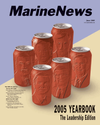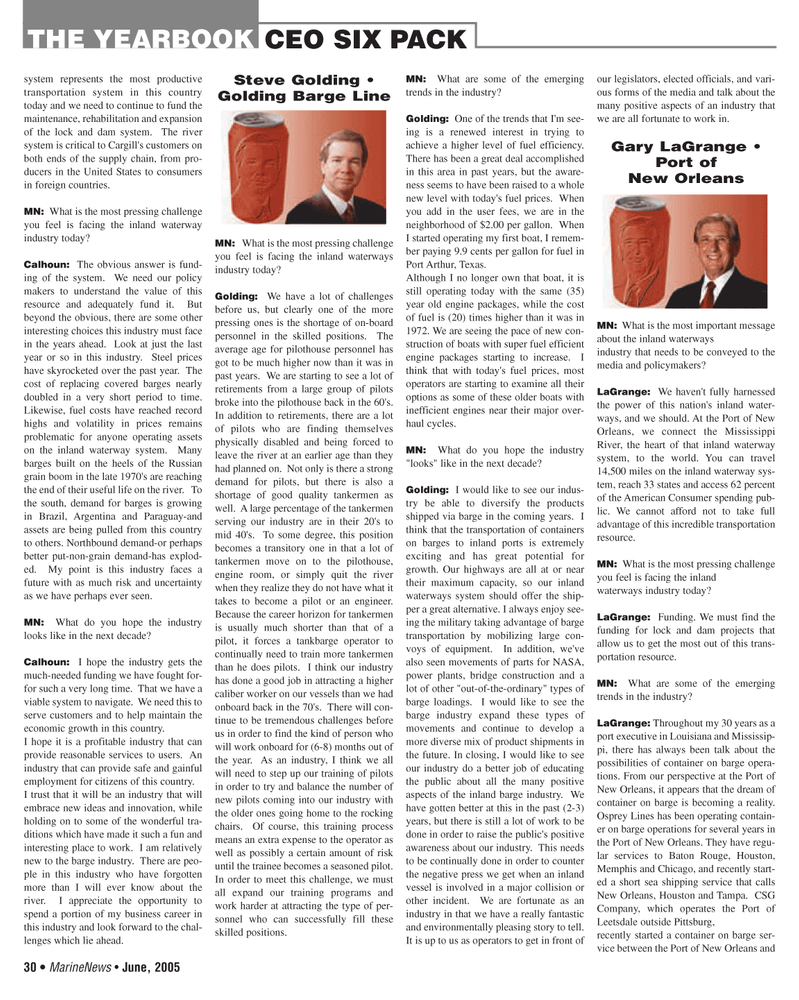
Page 30: of Marine News Magazine (June 2005)
Read this page in Pdf, Flash or Html5 edition of June 2005 Marine News Magazine
system represents the most productive transportation system in this country today and we need to continue to fund the maintenance, rehabilitation and expansion of the lock and dam system. The river system is critical to Cargill's customers on both ends of the supply chain, from pro- ducers in the United States to consumers in foreign countries.
MN: What is the most pressing challenge you feel is facing the inland waterway industry today?
Calhoun: The obvious answer is fund- ing of the system. We need our policy makers to understand the value of this resource and adequately fund it. But beyond the obvious, there are some other interesting choices this industry must face in the years ahead. Look at just the last year or so in this industry. Steel prices have skyrocketed over the past year. The cost of replacing covered barges nearly doubled in a very short period to time.
Likewise, fuel costs have reached record highs and volatility in prices remains problematic for anyone operating assets on the inland waterway system. Many barges built on the heels of the Russian grain boom in the late 1970's are reaching the end of their useful life on the river. To the south, demand for barges is growing in Brazil, Argentina and Paraguay-and assets are being pulled from this country to others. Northbound demand-or perhaps better put-non-grain demand-has explod- ed. My point is this industry faces a future with as much risk and uncertainty as we have perhaps ever seen.
MN: What do you hope the industry looks like in the next decade?
Calhoun: I hope the industry gets the much-needed funding we have fought for- for such a very long time. That we have a viable system to navigate. We need this to serve customers and to help maintain the economic growth in this country.
I hope it is a profitable industry that can provide reasonable services to users. An industry that can provide safe and gainful employment for citizens of this country.
I trust that it will be an industry that will embrace new ideas and innovation, while holding on to some of the wonderful tra- ditions which have made it such a fun and interesting place to work. I am relatively new to the barge industry. There are peo- ple in this industry who have forgotten more than I will ever know about the river. I appreciate the opportunity to spend a portion of my business career in this industry and look forward to the chal- lenges which lie ahead.
Steve Golding •
Golding Barge Line
MN: What is the most pressing challenge you feel is facing the inland waterways industry today?
Golding: We have a lot of challenges before us, but clearly one of the more pressing ones is the shortage of on-board personnel in the skilled positions. The average age for pilothouse personnel has got to be much higher now than it was in past years. We are starting to see a lot of retirements from a large group of pilots broke into the pilothouse back in the 60's.
In addition to retirements, there are a lot of pilots who are finding themselves physically disabled and being forced to leave the river at an earlier age than they had planned on. Not only is there a strong demand for pilots, but there is also a shortage of good quality tankermen as well. A large percentage of the tankermen serving our industry are in their 20's to mid 40's. To some degree, this position becomes a transitory one in that a lot of tankermen move on to the pilothouse, engine room, or simply quit the river when they realize they do not have what it takes to become a pilot or an engineer.
Because the career horizon for tankermen is usually much shorter than that of a pilot, it forces a tankbarge operator to continually need to train more tankermen than he does pilots. I think our industry has done a good job in attracting a higher caliber worker on our vessels than we had onboard back in the 70's. There will con- tinue to be tremendous challenges before us in order to find the kind of person who will work onboard for (6-8) months out of the year. As an industry, I think we all will need to step up our training of pilots in order to try and balance the number of new pilots coming into our industry with the older ones going home to the rocking chairs. Of course, this training process means an extra expense to the operator as well as possibly a certain amount of risk until the trainee becomes a seasoned pilot.
In order to meet this challenge, we must all expand our training programs and work harder at attracting the type of per- sonnel who can successfully fill these skilled positions.
MN: What are some of the emerging trends in the industry?
Golding: One of the trends that I'm see- ing is a renewed interest in trying to achieve a higher level of fuel efficiency.
There has been a great deal accomplished in this area in past years, but the aware- ness seems to have been raised to a whole new level with today's fuel prices. When you add in the user fees, we are in the neighborhood of $2.00 per gallon. When
I started operating my first boat, I remem- ber paying 9.9 cents per gallon for fuel in
Port Arthur, Texas.
Although I no longer own that boat, it is still operating today with the same (35) year old engine packages, while the cost of fuel is (20) times higher than it was in 1972. We are seeing the pace of new con- struction of boats with super fuel efficient engine packages starting to increase. I think that with today's fuel prices, most operators are starting to examine all their options as some of these older boats with inefficient engines near their major over- haul cycles.
MN: What do you hope the industry "looks" like in the next decade?
Golding: I would like to see our indus- try be able to diversify the products shipped via barge in the coming years. I think that the transportation of containers on barges to inland ports is extremely exciting and has great potential for growth. Our highways are all at or near their maximum capacity, so our inland waterways system should offer the ship- per a great alternative. I always enjoy see- ing the military taking advantage of barge transportation by mobilizing large con- voys of equipment. In addition, we've also seen movements of parts for NASA, power plants, bridge construction and a lot of other "out-of-the-ordinary" types of barge loadings. I would like to see the barge industry expand these types of movements and continue to develop a more diverse mix of product shipments in the future. In closing, I would like to see our industry do a better job of educating the public about all the many positive aspects of the inland barge industry. We have gotten better at this in the past (2-3) years, but there is still a lot of work to be done in order to raise the public's positive awareness about our industry. This needs to be continually done in order to counter the negative press we get when an inland vessel is involved in a major collision or other incident. We are fortunate as an industry in that we have a really fantastic and environmentally pleasing story to tell.
It is up to us as operators to get in front of our legislators, elected officials, and vari- ous forms of the media and talk about the many positive aspects of an industry that we are all fortunate to work in.
Gary LaGrange
Port of
New Orleans
MN: What is the most important message about the inland waterways industry that needs to be conveyed to the media and policymakers?
LaGrange: We haven't fully harnessed the power of this nation's inland water- ways, and we should. At the Port of New
Orleans, we connect the Mississippi
River, the heart of that inland waterway system, to the world. You can travel 14,500 miles on the inland waterway sys- tem, reach 33 states and access 62 percent of the American Consumer spending pub- lic. We cannot afford not to take full advantage of this incredible transportation resource.
MN: What is the most pressing challenge you feel is facing the inland waterways industry today?
LaGrange: Funding. We must find the funding for lock and dam projects that allow us to get the most out of this trans- portation resource.
MN: What are some of the emerging trends in the industry?
LaGrange: Throughout my 30 years as a port executive in Louisiana and Mississip- pi, there has always been talk about the possibilities of container on barge opera- tions. From our perspective at the Port of
New Orleans, it appears that the dream of container on barge is becoming a reality.
Osprey Lines has been operating contain- er on barge operations for several years in the Port of New Orleans. They have regu- lar services to Baton Rouge, Houston,
Memphis and Chicago, and recently start- ed a short sea shipping service that calls
New Orleans, Houston and Tampa. CSG
Company, which operates the Port of
Leetsdale outside Pittsburg, recently started a container on barge ser- vice between the Port of New Orleans and 30 • MarineNews • June, 2005
CEO SIX PACKTHE YEARBOOK
JUNEMN2005 4(25-32).qxd 5/25/2005 8:36 PM Page 30

 29
29

 31
31
